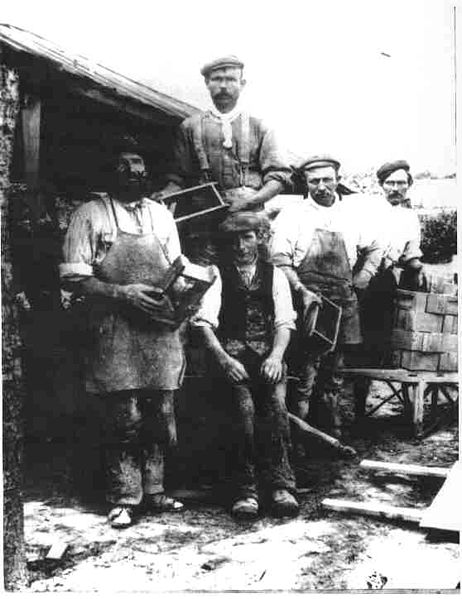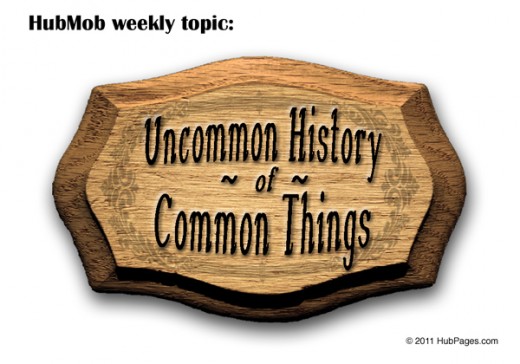Bricks Used as material for Masonry, Building, Paving, Decorartion
Brickmaking at the turn of the century

Devalan Wisconsin historic brick street

How many of us really notice a common building material like bricks? Bricks are so much a part of our environment that we hardly notice them
Bricks include clay bricks, glass bricks red bricks, brick tiles, paving bricks, patio bricks, and fire bricks. The uses include brick flooring, masonry, brick paneling, retaining walls, brick paving, brick buildings, and brick walls.
There is even a game about bricks called brick breaker:
Brick Breaker is a Breakout clone[1] in which the player must smash a wall of bricks by deflecting a bouncing ball with a paddle. The paddle may move horizontally and is controlled with the Blackberry’s track wheel. When all the bricks have been destroyed, play advances to a new level.
From Wikipedia
. Generally we see them as a component of something else, such as a house. In the United States, at least, brick facades are popular in modern houses as opposed to actual brick. Sometimes they are used for very mundane things such as shelves to hold books, for those who still have books. Combinations of bricks and boards are very good for makeshift bookshelves or with some paint or stain you can make some rather attractive ones.
I like to get into older towns or neighborhoods that still have brick streets that may have been made over a hundred years ago and still work pretty well.

The oldest bricks found, according to Wikipedia, were shaped mud somewhere around 7500 B.C. and were found in the upper
tigress region. Egyptians also used fired brick. In the Indus valley civilization used clay bricks exclusively.
Romans
The Romans used fired bricks. The Roman legions had mobile kilns and they introduced bricks to many parts of the Empire. The mark of the legion is often stamped on roman bricks. In southern and Western Germany bricks can be traced back to the traditions that were described by the roman architect Vitruvius.


China
Lowly unskilled artisans in pre-modern China did brick making. The kiln master had respect a step above the brick maker. In 2009 traces of bricks were found in Xi’an Ruin site of about 3800 years ago. Prior to this it was generally thought that bricks first appeared in Western Zhou dynasty about3000 years ago. These were the first fired bricks. A Song Dynasty carpenter’s manual from 1103 had a method for glazing techniques.
Europe
Bricks from Northern western Italy were re-introduced to Northern Germany in the 12th century. An independent tradition there led to the “Brick Gothic” which was a reduced style of Gothic architecture flourishing in Northern Europe. Especially around the Baltic Sea there is little natural rock. Brick Gothic buildings are found in Denmark, Germany, Poland, and Russia.
Visible brick walls were unpopular during the Renaissance and Baroque periods. They often covered the brickwork with plaster. In the middle of the 18th century visible brick started to regain popularity.
In Britain during the Industrial revolution buildings were often made with brick rather than rock for cheaper building costs. In a building boom to he 19th century Boston and New York City used locally made brick in construction for much the same reasons - economy of construction.

Brick Manufacturing
Bricks can be made from clay, shale, soft slate, calcium silicate, concrete, or shaped quarry stone. Usually brick contains silica, Alumna, Lime, Iron Oxide and Magnesia.
The most common is clay brick and can be made by soft mud, dry press or extruded processes.
Mud.
The most common method is the soft mud because it is most economical. Raw clay, preferably in a 25-30% sand mix to reduce shrinkage clay is ground and mixed with water, and then pressed into steel molds with a hydraulic press. The shaped clay is then fired at 900-1000C for strength.
In modern brickworks it is usually done in a continuously fired kiln. The bricks move slowly through the kiln on conveyors, rails or kiln cars to achieve consistency. Often lime, ash, and organic matter are added to speed the burning.
India
In India it is typically done manually. Most commonly used is the Bull’s Trench kiln based on a design that British engineer W. Bull developed in late 19th century. It is continuous like the rail system.
Dry pressed method is similar to mud brick but starts with a much thicker mixture of clay so it is more accurate and gives a sharper edge to the brick.
Extrusion For extruded bricks the clay is mixed with water and forced through a die to create a long cable of material. It is then cut into bricks.
Calcium silicate bricks include lime mixed with quartz, crushed flint or crushed silicate rock. It is molded and cured.
Uses
Bricks are used in building and pavement. In the USA brick pavement was discarded because it apparently did not stand up to heavy traffic. However it is making a comeback as a way to calm traffic and in some places as a decorative surface in pedestrian precincts.
Bricks are also used in the metallurgy and in glass industries to line furnaces. In the United Kingdom bricks have been









